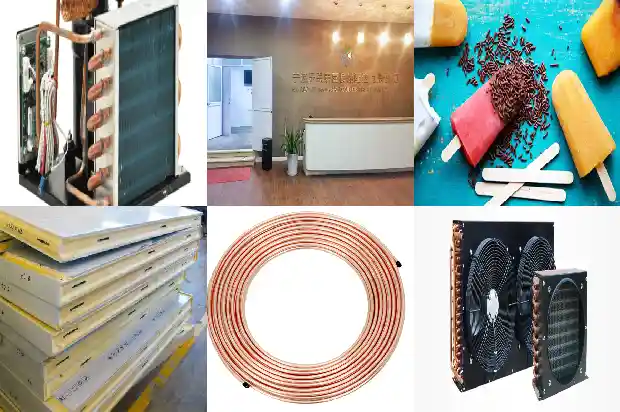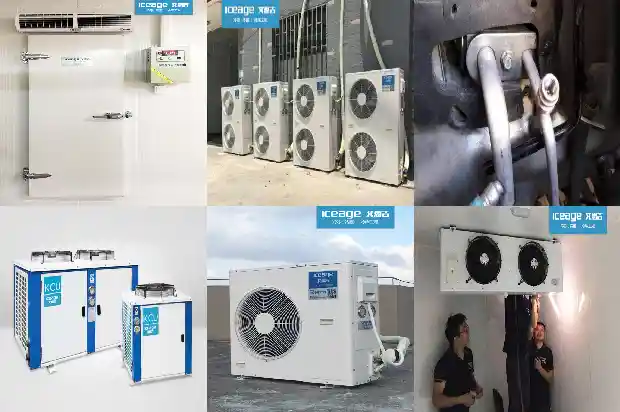Troubleshooting Ideas for Common Failures of Refrigeration Systems
2024-10-08
Today, we will roughly share four commonly used troubleshooting ideas:
- Pressure is only an appearance. Deeply understand the law of pressure change:
What we can usually see from a refrigeration device is the high and low pressure of the system. In some refrigeration systems, such as air source heat pumps and small Freon cold storage devices, high and low pressure gauges are installed. Due to cost reasons, small refrigeration devices such as household air conditioners, refrigerators, and dehumidifiers choose not to install high and low pressure gauges. Many colleagues do not understand why high and low pressures need to be tested?
Refrigerant is equivalent to blood in the human body. Usually, high or low blood pressure in the human body is abnormal. For example, hypertension easily suffered by the elderly is caused by the accumulation of fat in blood vessels (or other reasons), resulting in a smaller actual area for blood circulation in blood vessels and increased resistance. High blood pressure needs to be increased to help blood circulation. In a refrigeration system, dirt blockage in pipelines/thermal expansion valves, etc. will also cause the high pressure to be extremely high instantly.
Let's take analyzing high pressure as an example:
The pressure before throttling is called high pressure or condensation pressure. The physical meaning is a saturation pressure at which the refrigerant condenses into a liquid in the condenser. This pressure is usually related to the condenser, such as:
The heat exchange area of the condenser;
The heat exchange effect of the condenser;
The heat exchange medium of the condenser;
The working condition of the condenser, etc.;
We can think that the most direct influencing factor of condensation pressure is the temperature of the working condition. For example, for air-cooled heat exchangers, the condensation temperature is usually about 15-20°C higher than the working condition temperature. The design parameters on the outside of a general household air conditioner: working condition temperature 35°C/24°C, and its condensation temperature design value is 54.4°C.
When analyzing abnormal high pressure, the first thing we consider is whether the heat exchanger is normal. If the condensation effect is not good, the high pressure is usually high. We have summarized as follows:
Condensation pressure is what we usually call "high pressure". Condensation pressure system failures usually have three types: - Condensation pressure is too high;
- Condensation pressure is too low;
- Pressure vibration;
Refrigerant pressure is too high:
The possible causes of too high condensation pressure are usually as follows:
a), Air or other incompressible gases in the refrigeration system;
b), The condenser surface is too small;
c), The refrigeration system is overcharged too much (liquid recovery in the condenser);
d), The condensation pressure regulation is set to a too high pressure;
e), Dirt on the condenser surface.
The above are the common fault causes of air cooling and water cooling:
Troubleshooting methods:
a), Clear the condenser by starting and running the system using a recovery system until the system reaches operating temperature. If necessary, clear it again;;
b), Replace with a larger condenser;
c), Recover the refrigerant until the condensation pressure is normal. The sight glass must remain full;
d), Set the correct pressure;
e), Clean condenser.
Regarding air condensers (finned heat exchangers), for high pressure alarms, the following aspects usually need to be analyzed:
1), Defective or too small fan motors or blades.
2), Restricted air flow to the condenser.
3), The ambient temperature is too high.
4), The airflow passing through the condenser is in the wrong direction.
5), Short circuit between the air side pressure and the suction side of the condenser fan.
Troubleshooting methods:
1), Replace the engine or blade, or replace the engine and blade at the same time.
2), Remove obstacles at the air inlet or move the condenser.
3), Form a clean air inlet or move the condenser.
4), Change the rotation direction of the fan motor. The air in the condensing device must flow through the condenser and then flow into the compressor.
5), Install pipes that may be suitable for outdoor air.
Regarding water-cooled condensers (finned heat exchangers), for high pressure alarms, the following aspects usually need to be analyzed:
1), The cooling water temperature is too high;
2), The water volume is too small;
3), Sediment (dirt, etc.) inside the water pipe;
4), The cooling water pump is defective or stops working.
Troubleshooting methods:
1), Ensure a lower water temperature;
2), Increase the water volume. It is possible to use an automatic water valve to increase the water volume;
3), Clean the condenser water pipe. Deoxidation may be used for removal;
4), Investigate the cause and replace or repair the cooling water pump (if installed).
Condensation pressure is too low:
Common reasons are as follows:
a), The condenser surface is too large;
b), The load on the evaporator is small;
c), The suction pressure is too low, for example, there is insufficient liquid in the evaporator;
d), The compressor suction valve or discharge valve may leak;
e), The pressure setting of the condensation pressure regulating valve is too low;.
f), The uninsulated receiver placed is supercooled compared to the condenser (the receiver is used as a condenser);
g), The cooling air temperature is too low; (air cooling)
h), The air volume of the condenser is too large; (air cooling)
j), The water volume is too large; (water cooling)
k), The water temperature is too low. (water cooling)
How to troubleshoot?
According to the above faults, we troubleshoot one by one according to the following methods:
a), Adjust the condensation pressure or replace the condenser;
b), Adjust the condensation pressure;
c), Look for faults on the pipeline between the condenser and the thermal expansion valve (please refer to "low suction pressure");
d), Replace the compressor valve plate;
e), Set a correct pressure for the condensation pressure regulating valve;
f), Move the receiver or install a suitable insulation cover for the receiver;
g), Adjust the condensation pressure;
h), Replace a smaller fan or adjust the motor speed;
j), Reduce the cooling water flow;
k), Increase the cooling water temperature. - Masters must have a good sense of touch and know whether the temperature is normal just by touching!
As a refrigeration after-sales engineer, one must master the troubleshooting methods of "observation, smelling, asking, and feeling" like a doctor;
Observation: Look and observe; whether there are abnormal situations;
Smelling: Smell the odor and listen for abnormal sounds;
Asking: Ask the customer about the specific fault phenomenon;
Feeling: Touch the temperature of the components and pipelines of the refrigeration system;
This time we mainly look at "feeling". By touching the temperature of various components and pipelines of the refrigeration system with our hands, we can judge whether it is normal. As for the approximate temperature of the entire refrigeration system, we must have a clear grasp:
Feeling the temperature of exhaust pipes: Whether the exhaust temperature is normal can be judged according to the condensation temperature. How much is the condensation temperature? We can judge it according to the ambient temperature or the reading of the high-pressure gauge. Make a preliminary judgment according to the following experience:
Condensation temperature = ambient temperature + 15~20°C;
Exhaust temperature = condensation temperature + 20~30°C;
If the exhaust temperature feels relatively low, we can initially think that the suction superheat is too small. So the exhaust temperature is also low. The reasons for the small suction superheat can be initially judged to be caused by too large opening of the thermal expansion valve or too much refrigerant charge.
Feeling the suction temperature: The suction temperature is also a relatively important parameter. It can be used to judge whether the throttling mechanism is adjusted properly and whether the refrigerant charge is appropriate, etc. The main judgment basis is also the suction superheat.
Suction superheat = suction temperature ~ evaporation temperature; (The evaporation temperature depends on the reading of the low-pressure gauge)
Large suction superheat: The opening of the thermal expansion valve is too small;
Small suction superheat: The opening of the thermal expansion valve is too large;
Feeling the temperature of the condenser: There are water-cooled condensers and air-cooled condensers. Let's take a water-cooled shell-and-tube condenser as an example. Generally, the upper part of the shell tube is at high temperature, the middle is around the condenser temperature, and the lower part is cold. This is because the upper part of the shell tube is superheated steam of the refrigerant, the middle is saturated refrigerant at the condensation temperature, and the lower part is in a supercooled state;
Feeling the temperature of the inlet and outlet water. The inlet water temperature of the shell-and-tube condenser is generally about 25-35°C, and the outlet water temperature is about 5°C higher than the inlet water temperature. Usually, we can also judge some basic problems according to this temperature:
High inlet water temperature: It indicates that the cooling effect of the cooling tower is not good. Check whether the cooling tower fan is running normally and whether the cooling tower is too dirty, resulting in poor heat transfer;
Small temperature difference between inlet and outlet water (temperature lower than 5°C); It indicates that the heat transfer effect of the shell tube is poor. The water flow cannot take away the heat, so the outlet water temperature is low.
Large temperature difference between inlet and outlet water (temperature greater than 5°C); It indicates that the water flow is small.
Under certain conditions of a heat exchanger with a small water flow, the temperature difference will be large...
- Summary:
Through the above two basic methods of fault diagnosis and troubleshooting, as people in the refrigeration industry, we must carefully understand and conduct in-depth research. The refrigeration system is also a system that interacts with each other. There are many causes of a fault. We need to eliminate the causes one by one and finally find the real cause of the fault. At the same time, the faults of the refrigeration system are not absolute. We cannot say that a certain operation will definitely lead to a certain problem. We need to analyze comprehensively.
Related Articles
- Analysis and Troubleshooting of Common Faults in Air - source Heat Pumps
- Common Faults and Troubleshooting Methods of the Moving Mechanism of Piston Compressors
- Top Ten Components of Refrigeration Systems and Five Common Troubleshooting!
- Some Simple Troubleshooting for Combined Cold Storages
- Maintenance Methods for Small Modular Cold Storage Failures
- Do You Know These Four Scenarios That Can Cause Compressor Failures?
- Refrigeration System Failures: Handling System Blockages and Water Infiltration
- Solutions to Common Compressor Failures
- Effective Measures to Prevent Compressor Failures in Industrial Chillers
- Reasons for Pump Body Failures in Cold Storage Compressors
- Refrigeration System Components and Common Failures
- Common Causes of Air Conditioner Compressor Failures
- Have You Encountered the Three Common Problems of Refrigeration Compressors?
- How to Calculate Refrigeration Load? And What Are the Issues?
- What to Do if the Compressor of a Frozen and Refrigerated Display Cabinet Runs but the Refrigeration Effect Is Poor?
- Instructions for Welding and Drainage in the Installation of Refrigeration Equipment Pipelines
- Common Pressure Valves and Protection Devices in Refrigeration Units
- Precautions for Using Rotary Refrigeration Compressors
